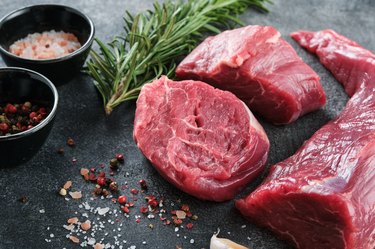
Calling all carnivores: Love red meat, but concerned about your blood pressure levels? You don't necessarily have to give up meat completely. While high-sodium processed meats can raise your blood pressure, not all red meat is a mistake in moderation. Here's how red meat affects BP.
Read more: 4 Benefits of Eating Red Meat in Moderation
Video of the Day
Video of the Day
Does Red Meat Raise Blood Pressure?
The USDA includes beef, veal, lamb and pork in its definition of red meat. Not all red meats look precisely red in color, but all do have a deeper color, and this color is determined by the amount of a protein called myoglobin that's present in the meat, according to the USDA.
But if you love red meat and are worried about your blood pressure, you'll be happy to know that research doesn't prove a negative association for all cuts of red meat.
A November 2016 meta-analysis in the American Journal of Clinical Nutrition looked at the inconsistencies in studies on the observational links between red meat consumption and heart disease and concluded that eating one-half serving or more of red meat a day does not affect blood pressure.
An April 2019 meta-analysis of 36 studies involving a total of 1,803 participants in Circulation supports these findings. There was no remarkable difference between diets with red meat and all other diets regarding the effect on blood pressure (as well as other cardiovascular disease risk factors). Plant-protein diets specifically showed more of an edge over red meat diets when it came to healthier changes in blood lipids and lipoproteins.
If you eat red meat, you should limit it to no more than about three portions a week, according to the World Cancer Research Fund (WCRF). That translates to roughly 12 to 18 ounces (cooked weight) per week. This WCRF recommendation was chosen as a way to get the benefits of eating red meat for nutrients (like protein and iron) and also to limit it to a moderate amount per week, as there is evidence that red or processed meats are linked to colorectal cancer.
Worst Meats for High Blood Pressure
Not all red meats are created equal, according to Benjamin J. Hirsh, MD, double board-certified cardiologist and director of preventive cardiology at Sandra Atlas Bass Heart Hospital in North Shore University Hospital in Manhasset, New York.
"In terms of blood pressure, the worst red meats are those with high levels of saturated fat and high levels of sodium — cured meats," Dr. Hirsh says.
He says these "are usually high in fat and sodium, and are particularly bad for your heart health" and include:
- Sausages.
- Hot dogs.
- Cured bacon.
- Processed deli meats.
Dr. Hirsh points out that "food with significant sodium or salt content can raise blood pressure, both in the short term and long term."
To avoid this problem, the National Heart, Lung, and Blood Institute (NHLBI) suggests passing on these higher-sodium meats and meat-related condiments and spices:
- Smoked and cured meats (ham, bacon, sausage).
- Bologna.
- Hot dogs.
- Fatback.
- Ham hocks.
- Scrapple.
- Liver pudding.
Foods That Encourage Low Blood Pressure
While science supports no clear-cut negative association between consuming unprocessed red meats with low levels of sodium — in moderation — and rising blood pressure, it doesn't mean that red meat should top your dietary roster for optimal heart health.
If you do want to eat red meat, look for leaner cuts. According to the American Heart Association (AHA), these leaner cuts often include "round," "loin" or "sirloin" in their descriptions. Portions are important too: one serving is roughly the size of a deck of cards, AHA says.
Dr. Hirsh says the "the best foods for lowering blood pressure" are:
- Fresh fruits.
- Vegetables.
- Nuts.
- Olive oils.
- Whole grains.
And "in terms of proteins, the best for lowering blood pressure are those high in omega-3s — namely fatty fish," Dr. Hirsh says.
According to the NHLBI, you should also opt for the following foods to encourage healthy blood pressure levels and overall heart health:
- Grilled or baked chicken and turkey (skinless).
- Fresh fish.
- Rinsed canned fish (tuna, sardines).
- Spices, herbs and flavorings as salt replacements (like parsley,
garlic powder, onion powder).
- American Journal of Clinical Nutrition: “Total Red Meat Intake of ≥0.5 Servings/d Does Not Negatively Influence Cardiovascular Disease Risk Factors: A Systemically Searched Meta-Analysis of Randomized Controlled Trials”
- Circulation: “Meta-Analysis of Randomized Controlled Trials of Red Meat Consumption in Comparison With Various Comparison Diets on Cardiovascular Risk Factors”
- Benjamin J. Hirsh, MD, double board-certified, director, Preventive Cardiology, Sandra Atlas Bass Heart Hospital, North Shore University Hospital, Manhasset, New York
- World Cancer Research Fund: “Limit Red and Processed Meat”
- National Heart, Lung, and Blood Institute: “Choose Foods Low in Sodium”
- U.S. Department of Agriculture: “Beef From Farm to Table”
- American Heart Association: “Meat, Poultry, and Fish: Picking Healthy Proteins”